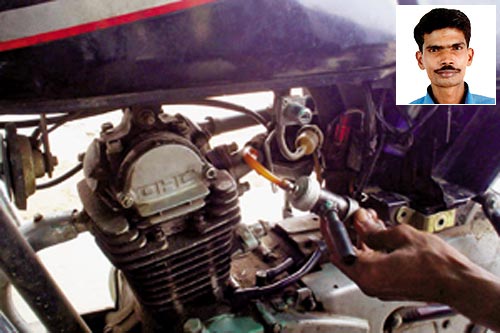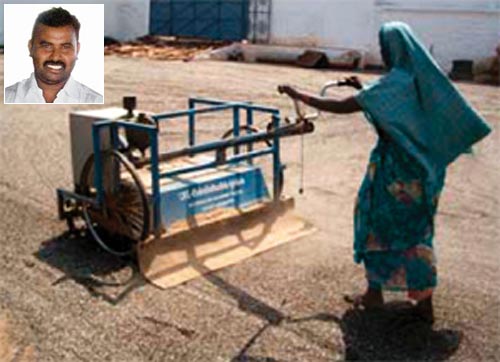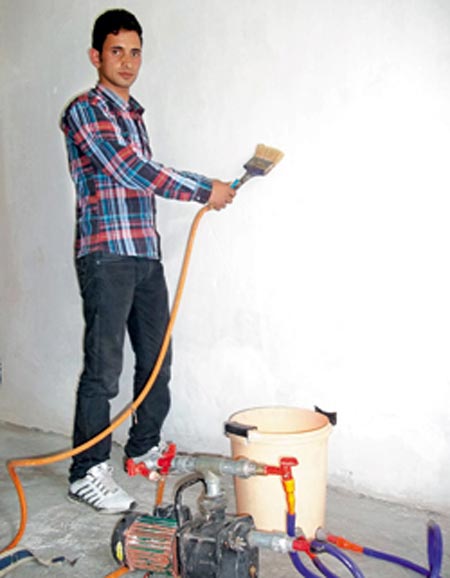 | « Back to article | Print this article |
Meet 5 engineers with NO engineering degrees
Find out how ordinary Indians with no premium degrees but exceptional engineering aptitude use their analytical abilities and critical approach to have come up with grassroots inventions aimed at making everyday tasks easier.
The oft repeated saying "Necessity is the mother of all invention" aptly summarises the basis of many innovations.
The pressing need to do things better and efficiently has egged on mankind to innovate since time immemorial. The urge has not faded.
Meet five innovators -- some who could not even afford to go to school -- who persevered and came up with creative solutions to problems that affect people everyday.
Name: Hari Narayan Prajapat
Age: 38
Profession: Automobile Mechanic, Rajasthan
Innovation: Mileage booster
A common question that motorcycle owners pose to this mechanic is: How to increase the mileage of the bike? "I slowly began thinking in this direction and conceived an idea to develop a motorcycle that would work on compressed air," says Hari, the son of a mason.
Hari, 38, has developed a small kit which can be easily attached to a motorbike to increase fuel-efficiency. It comprises a piston and calibrated nozzle, which can be fitted in the fuel line between the carburettor and the entry to the cylinder head.
A Class VIII dropout, Hari liked machines since his childhood. His love for machines made him work in a garage alongside studies. He used to do petty automobile repair work until he opened his own two-wheeler repair workshop.
Most of the available techniques for increasing mileage are related to 'knocking'. It was very challenging to increase combustion efficiency.
In 2005, he started working on the innovation and spent many years, making prototypes but didn't taste much success. First, he made a vehicle that had a tank where compressed air was stored. This was used to drive the motorcycle only after certain changes in the engine. This attempt was unsuccessful. But the effort gave him direction.
He realised that he should do something, which would not require any change in the vehicle except some minor modification or attachment. He kept experimenting around fuel burning and air compressor to increase combustion efficiency and which would result in increased vehicle mileage.
Ultimately Hari developed a kit that can be easily attached to any 4-stroke motorbike. It is fitted in the inlet manifold line and has a small piston inside a cylinder. Hari's mileage booster device has been tested at Malaviya National Institute of Technology (MNIT) Jaipur, and about 23 percent increase in mileage at the speed of 35 km/h has been reported. He has sold about 1500 pieces of this kit and has even applied for a patent.
2. Innovation to help coconut tree climbers
Name: DN Venkat
Age: 49
Profession: Farmer, Tamil Nadu
Innovation: The coconut tree climber
Many grassroots inventions stem from a need to overcome difficulties in common chores. One such task would be climbing coconut trees.
Hailing from Coimbatore, this farmer noticed the difficulty that people faced while climbing the tall coconut and palm trees, which grow in abundance in Southern India. He decided to address the issue and came up with a low-cost tree climber.
The farmer's invention has a sitting arrangement for climbers, complete with a safety belt. It has two frames; upper one is operated by hand while the lower end is operated by leg.
The user can sit comfortably on the seat and climb up to 40 feet in just five minutes. A major advantage of this machine is that it is can be used on trees with different girth.
The real challenge was to design a simple, affordable and safe tree-climber. It would have been easy to design a heavy machine which could pull a climber to a tree. But it wouldn't have been cost-effective and portable.
Venkat started his work in 2007 and in a year's time found himself giving the finishing touches to his invention.
During this period, he made two prototypes.
In 2008, he concluded with the improvised version of his tree-climber. At present, Venkat is selling the device for Rs 7,000. He is also exporting units to some South Asian countries.
The University of Agricultural Sciences, GVK, Bangalore has tested the device as part of an all-India co-ordinated research project on Post Harvest Technology and found it useful for climbing coconut palms.
3. Innovator of seed spreader
Name: R Ravi
Age: 37
Profession: Mechanic,Tamil Nadu
Innovation: Seed spreader
The routine operation of spreading seeds evenly on the ground to dry is a job that requires quite a lot of labour.
R Ravi, a mechanic from Erode has mechanised the seed spreading process.
The 37-year-old developed an engine-operated paddy spreader for fast and efficient spread of paddy, oil seeds, millets, coriander etc. The innovative solution helps in quick drying of the seeds and therefore is a boon to farmers and small-scale industries.
This Class VIII dropout worked as an electrician for almost five years, then as a mechanic for about a year in a local firm. Thereafter, he opened his own workshop. While repairing machines at mills, Ravi observed the difficulty people faced in spreading seeds.
"Apart from the difficulty in spreading the seeds manually, the labour cost involved is also quite high. A large number of workers are needed -- at least seven or eight workers per day -- to spread the paddy quickly for proper and uniform drying," he shares.
For best results, the thickness of a paddy layer should be about 2.5 cm which would be a physically tiring task especially when labour costs are so high. The machine would be of immense help here.
Ravi started devising his machine and gave it to labourers for their feedback. Subsequently, improvements were made in the machine till the final one was ready.
The final version is a spreader that has a tricycle, loaded with a 50 cc petrol engine. This engine powers its rotary members made of rubber.
These rotary members are mounted on a shaft. When powered, the rotary members turn the grains. Since the members are made of rubber; there is no damage to the seeds.
This machine enables 20 tonnes of paddy to be spread with the help of just two labourers against 30 that were being deployed earlier for the task.
Each machine costs about Rs 30,000 and Ravi has sold about 200 such machines till date.
4. Innovator of kerosene stove without fuel tank
Name: Ghulam Mohammad Sheikh
Age: 47
Profession: Labourer, Jammu & Kashmir
Innovation: Kerosene stove sans fuel tank
Another example of innovative thinking is demonstrated by 47-year old Ghulam Mohammad Sheikh.
He designed a kerosene stove using pipes in such a way that there is no need for an additional fuel tank.
This stove is far more efficient than its traditional counterpart and has less chances of exploding.
The son of a labourer, Ghulam spent his childhood in extreme poverty. Their financial condition was so bad that he couldn't afford to buy an ordinary stove.
As he was growing up, he thought of designing a stove with mere iron pipes. On contemplating the concept, he realised that steel pipes can be used as a stand as well as for storage of fuel.
"But the challenge was to arrange pipes in such a way that both fuel and pressure gets distributed equally," he says.
After experiments and several trials, Ghulam was ultimately able to realise his dream. He designed a stove with pipes, the supporting structure doubles up as the stand and fuel-tank.
The kerosene is stored in these pipes. Since the fuel is stored in the pipes, the stove has a higher thermal efficiency due to pre-heating of kerosene. Because of better thermal efficiency, the stove is fuel-efficient as well.
The National Innovation Foundation recognised his efforts, and is supporting him towards developing more innovations. Ghulam Mohammad Sheikh has already moved on to his next mission: a bike that can ride over snow.
5. Innovation to help painters
Name: Jahangir Ahmad
Age: 19
Profession: Student, Jammu & Kashmir
Innovation: Painter's job made easy
Painting one's home is considered as a tedious job. But not with an electric painting brush.
Jahangir developed an automatic electric painting brush which works without the need to dip the brush in the paint bucket. With his innovation, paint which usually gets wasted due to spillage is saved.
The son of a carpenter from Anantnag, Jahangir comes from a financially unstable family.
"I noticed some workers painting a high wall near my home. I observed that there was little space to keep the paint bucket and the workers were struggling to hold on tight to the ladder, dip the brush in the bucket and paint the wall smoothly. I saw that during the painting process, a lot of paint was being wasted. That's when I thought: why not make a painter's job easy?" he recalls.
The challenge was to design something, which was simple and easy to operate on high walls. The other challenge was to facilitate the user to control the flow of the paint.
With a pump, he tried to supply paint straight to the brush without dipping in a bucket. For equal distribution of paint from the brush, he designed a special brush with a distributor built within.
Jahangir's electric painting system consists of a pump operated by one horsepower motor. This motor pumps the paint into especially made brushes through flexible pipes.
A lever is provided to start and stop the flow of paint. The paint comes out at the base of the bristles at four places gets widely distributed. Looking at its commercial potential a patent has been filed in the name of Jahangir. So, the day is not too far when you may come across a "Jahangir Brush" in the market.
Besides studies, Jahangir also has interest in painting and poetry, mostly in Urdu and English. He's also writing a journal about his life. Jahangir feels it is a good way to look at oneself objectively and introspect.




